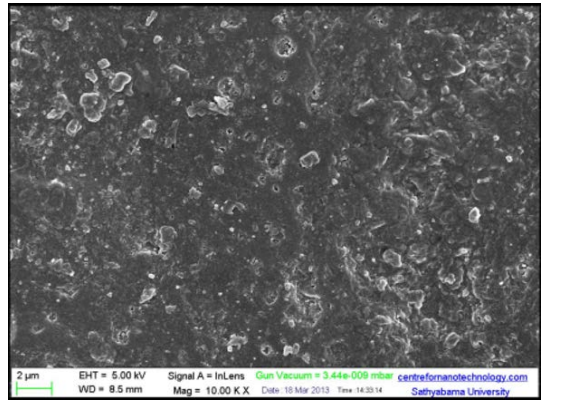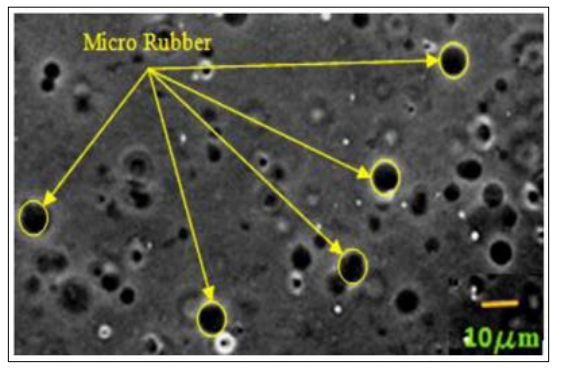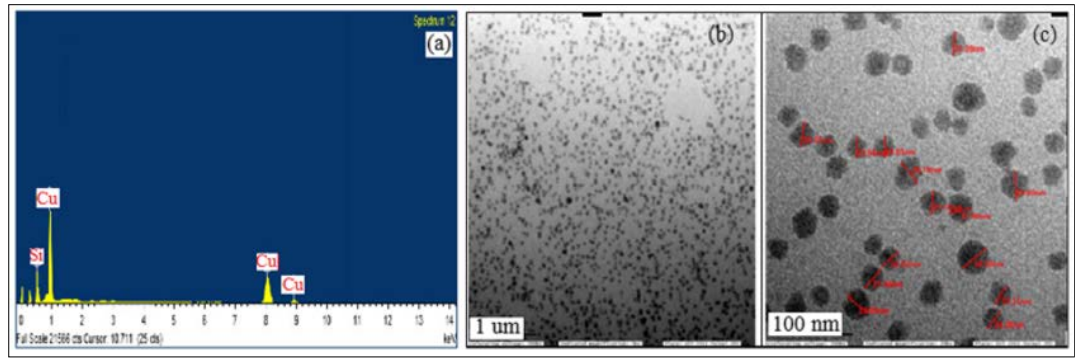Author(s): N Gokraneshan*, V Sathya, Sona M Anton, PG Anandhakrishnan, C Kayalvizhi and SH Ritti
The article provides some significant insights on the properties of nano glass fibre composites. Fiber reinforced polymer (FRP) composites plays an important role in many industries; because weight to strength ratio is extremely high when compared to monolithic metals. One of the main limitations of FRP composites are the low mechanical properties due to the presence of polymer associated with it. To solve this problem, material engineers are investigating the use of different nanoparticles mixed in different polymers to improve mechanical properties of the polymer. Nano Copper Oxide (CuO) materials dispersed in polystyrene resin using ultrasonic bath sonicator are used as matrix face for glass fiber reinforced plastics which is manufactured by hand layup processes. As per ASTM standards tensile and compression test are carried out in universal testing machine. Microstructure of samples has been investigated by scanning electron microscope (SEM). Hence the dispersion of reinforcement was noted. The mechanical properties and fracture toughness of woven fabric Glass/Kevlar based hybrid composite tailored using modified epoxy with micro rubber and nano silica. The principal aim of this work is to clarify the importance of hybrid fibre/filler addition and stacking sequence of fibre reinforcement in epoxy matrix. The epoxy was modified with addition of 9% micro rubber and 11% of nano silica by weight fraction. Both glass and kevlar woven mats were made by hand weaving and the composites were prepared using hand lay-up method.
Composites filled with nano-fillers such as nanoparticles, known as nano composites, are gaining increased attention recently. It has been expected that nano composites could provide superior physical properties, because of the high surface-to-volume ratio of nanometer scale reinforcing fillers embedded in the matrix, compared to the conventional fiber or particle reinforced composites. Polymer nano composites have attracted great interest, both in industry and in academics, because they exhibit remarkable improvement in material properties compared with virgin polymer or conventional micro and macro composites [1]. Conventional composites usually require a high content (> 10%) of the inorganic fillers to impart the desired mechanical properties. Such high filler levels increase their density of the product and can cause the deterioration in properties through interfacial incompatibility between the filler and the organic material. Besides, process ability worsens as filler content increases. In contrast, nano composites show enhanced thermo mechanical properties even with a small amount of layered silicate «5%). Polymer nano composites are generally defined as the combination of polymer matrix and fillers that have at least one dimension in nanometer range. The nano fillers can be one-dimensional, two-dimensional, and three- dimensional [2]. Polymer nano composites are known for its outstanding mechanical properties like high elastic modulus, increased strength, barrier resistance, flame retardancy, etc. with very small addition «5 wt.%) of nano particles [3].
Glass fibers exhibit better tensile and compressive strength, and offers great resistance to chemical, heat, moisture, and fatigue properties. Glass fibers are also an excellent resin adhesion and economical. However, glass fibers have low impact strength, low strength to weight ratio and high density compared to other synthetic fibers. Therefore glass fibers are often combined with Kevlar fiber or carbon fiber. The favorable properties of Kevlar fibers are low weight, excellent strength to weight ratio, high impact resistance and great flexibility. Nevertheless, it has poor compressive strength, sensitive to moisture and relatively expensive.
Kanagaraj reported that there is a sharp increase in Young’s modulus with an increase of CNT concentration. Ultimate strength, toughness also increasing linearly with addition of CNT [4]. Toughness is the important property to determine the volumetric wear rate. Yang observed that multi-walled carbon nanotubes (CNTs) enhances the thermal stability of PP also the mechanical properties [5]. Ajayan and Schadler observed that nanotube reinforcement will increase the toughness of the polymer composites by observing energy because of their highly flexible elastic behavior during loading [6]. Also the bonding between nanotubes and the surface of the polymer matrix could be greatly enhanced by van der Waals force between these two. Lim et al. reported that the friction and wear rates are reduced through addition of CNTs in carbon/carbon composites [7]. Mahrclz et al studied about various nano filler which are most suitable for various polymers [8]. They reported that the effect of Barium Sulphate (BaS04) and Silicon Dioxide (SiOz) on angle ply GFRP laminates. Mahrholz et al studied about the quatitation of reinforcement effect of silica nano particle. They concluded that the amount of silica content improves the stiffness, strength and toughness of composites [9]. Davies and Magee studied the effect of strain rate on the glass epoxy /polyester composites [10]. Okoli and Smith studied the effect of strain rate on the tensile, shear and flexural propertied of glass epoxy laminate Transition metal oxide such as copper oxide (CuO and CU20), iron oxide (FeO, Fe203 or Fe304) and zinc oxide (ZnO) nano materials have special physicochemical properties arising from the quantum size effect and high specific surface area, which may be different from their atomic or bulk counterparts [11, 12]. Zhanhu Guo have prepared and characterized vinyl-ester based nano composites reinforced with CuO nanoparticles [13]. They observed that, an increase of about 15% in the tensile modulus for CuO nano particles reinforced composites as compared with the cured pure resin The literature has indicated that extensive work has been carried out in synthesis and characterization of glass fiber reinforced polymer matrix composites. Very limited investigations are available on transition metal oxide filled glass fiber reinforced polymer matrix composites. The present investigation is focuses on synthesis and characterization of nano CuO filled GFRP composites were prepared by hand layup technique. The mechanical behavior and microstructure of samples has been investigated and presented by scanning electron microscope (SEM).
The fibre used is E-glass, the resin used is polyester and filler is copper oxide. The following procedures have been adopted:

Figure 1: SEM image I % Nano Cuo filled GFRP Composites
Nano CuO filled Glass Fiber composites are successfully prepared using hand layup technique. An ultrasonic bath sonicator was used to ensure homogeneous dispersion of CuO nano particles into resin without agglomeration. The characterization of CuO nano particles filled carbon fiber composites were done using SEM with EDAX. A Linear regression model has been developed to predict mechanical properties of nano filled GFRP composites. The results indicated that the predicted values through the developed model are well agreement with the experimental results and with increase in weight % of nano CuO improves the the mechanical properties [14].
Mechanical Strength Characteristics of Hybrid Composites Hybridizing both glass and Kevlar fibers would produce a material, which has good impact resistance and tolerance, high strength and lightweight but decreases its compressive strength. Since the compressive strength of polymer composites depends on the properties of the resin system, in the present research, a stiffer and tougher resin system was developed by incorporating fillers to provide better lateral support to the fibers and enhance the resistance to crack initiation and propagation. Arun prakash et al. studied and concluded the effect of filler addition into glass- epoxy composite [15]. They reported that the addition of iron
(III) oxide particles along with E-glass fibre increased the tensile, flexural, impact and inter-laminar shear strength. Guru Raja et al. investigates the performance of Glass fiber/Aramid fiber/Epoxy sap crossover edge handle covers with different fiber introductions to portray the malleable properties [16]. They confirmed that the ductile properties for 0°/ 90° orientation were more than ±45°& 60°/30° oriented composites. Thus, the 0°/90° orientation could be suitable in the field of Automobile, Marine, and Aerospace because of the heap conveying limit. Manjunath et al. observed the tractable exhaustion properties of a glass fiber supported polymer (GFRP) with elastic molecule changed epoxy framework [17].
They affirmed that the expansion of 9% weight of elastic miniaturized scale molecule in the epoxy network enhanced the weakness life of a glass fiber strengthened plastic composites by 3 times. The addition of 10% wt. of silica nanoparticles in the epoxy grid of GFRP polymer demonstrates a relative impact in the wear properties. The break sturdiness increased to a great extent in FRP polymer composites with crossbreed epoxy network, i.e., rubber micro particles and silica nanoparticles. Fabricated a phosphoric acid solution treated Kevlar/ epoxy laminated composites and determined mechanical, fracture, and impact energy properties [18]. They reported that the chemical treatment significantly improved the degree of adhesion at interfaces between fibers and resin matrix, resulting in improved mechanical and interfacial strength with high fracture energy. Evaluated the mechanical behavior of epoxy composite reinforced with Kevlar plain fabric and glass/Kevlar hybrid fabric [19]. Their results from the mechanical tests showed that the structures developed with the hybrid material of Kevlar and glass fibers possess highest values of mechanical strength and specific stiffness. Liang found that the incorporation of nano-fillers into polymer resin system and FRP composites improved the compressive behaviors of composite systems [20]. Although in certain conditions, the compressive strength decreased with the increase of filler content, nevertheless the strength values were still higher compared to pure epoxies. Indicated that addition of SS-304 and AL-6061 metal wire mesh into glass-fibre epoxy composite improved mechanical and drop load impact behavior of composite material [21]. The inclusion of metal wire mesh along with glass fibre in epoxy matrix observed sudden impact energy under sudden load, which increased its stability. These literatures strongly indicated a better load bearing property of the nanocomposites. The present research aims to develop a new hybrid resin system which could be based on silica nanoparticles, and micro rubber for the fabrication of hand weaved hybrid Kevlar/ glass fiber composites. The silica nano particles could be used as filler, since it possesses high hardness, very high melting and boiling points and also high crystalline structure. This crystalline silica could acts as load observer in polymer composites under external loading conditions. Moreover the cost and production of silica nanoparticles are comparatively cheaper and easier than other types of particles. Similarly the micro rubber filler material could be selected as dispersant, since it holds very lower density, high abrasion resistance, high ductility and cheaper in cost. The matrix could be modified by blending pure epoxy resin (E100) with micro rubber and nano silica (E80-S11R9) based on rule of mixture. The lamina of 3 layers could be arranged in a systematic manner as three stacking sequences. The laminate stacking sequences could be designed based on the strength requirements. Since fibers play crucial role in load transfer, their system of arrangement needs to be analyzed well in manner. The proposed fibre arrangements could be symmetric layering [GG/KK/KK/GG], alternate layering [GG/ KK/GG/KK] and accumulate layering [GG/GG/KK/KK]. When the fibres are arranged subsequently one by one from the bottom and top side then the arrangement of fibres could be called as symmetric layering, but when the lamina (fibre layer) is get arranged one by one throughout the segment then the fibre arrangement could be called as alternative layering. Similarly when the fibres are accumulated fully in one side with another fibre in other side then the corresponding type could be called as accumulate layering. There are more different types of fibre orientations could be possible based on strength expectations. When high damping resistance required for composites then the fibre orientation could be in mixed direction. The 360° placed 45° fibre yarns resists maximum damping force by, which the composites could be a high damper material. The hand layup cum compression molding method could be selected since, it needs low process parameters like limited pressure, and no elevated temperature constrains and eases of processing. The testing and validation of various composites could be done based on ASTM standards. The test samples could be prepared by shearing process since, the process contain simple process constrains like lower pressure involvement, limited power requirements. These mechanically strengthen and toughened epoxy polymer matrix composites could be used in automobile, structural and high impact resistance prone zones. The high damping resistance of these materials wooing their application in automobile, structural, space shuttles and domestic applications.
The epoxy matrix used is a liquid DGEBA with average molecular weight of 190 g/mol. Triethylenetetramine, a low viscosity amine with viscosity of 20 cps and density of 0.98 g/cm3 was used as curing agent. The Glass fibre Kevlar yarns have been used. Nano- silica and micro-rubber has been selected as fillers. The curing catalyst TETA was purchased from MERCK India Ltd.
The following procedures have been adopted

Figure 2: Homogeneous Dispersion of 9wt % Micro Rubber in Epoxy Resin

Figure 3: TEM Images of Nano Silica Dispersed Epoxy
Figure 4: Warp and Weft Image of (a) E-glass and (b) kevlar yarns
The following tests have been carried out
A new hybrid resin system was developed based on silica nanoparticles and micro rubber for the fabrication of hand weaved hybrid Kevlar/glass fiber composites for high load withstanding application. The stacking sequence and orientation of fibre influences the mechanical behavior of E-glass/Kevlar hybrids at axial and bend loading conditions. The mechanical properties of hybrid E-Glass/Kevlar composite with Nano silica and micro rubber found to be higher than composites contain only fibre reinforcement. The fracture toughness results explicated that the combination of E-Glass/Kevlar composite with micro rubber epoxy is of higher value than plain epoxy and hybrid Nano silica/micro rubber epoxy. The stacking sequence of [(0°, 90°)/ (0°, 90°)] 4S GG/GG/KK/KK was found to be giving good mechanical properties than other stacking sequences. The SEM fractograph revealed interfacial cracking phenomenon in various composites. The composite, which contain hybrid glass/kevler fibre and nano silica of 11 wt % possesses greater interfacial bonding than other composites. These fracture toughness and mechanical strength improved epoxy hybrid composites are highly preferred in automobile body manufacturing, machinery lateral body manufacturing, air-craft vehicle manufacturing industries, structural, electronic components (computer bodies) and domestic sectors. As a future research, surface modification of various reinforcements using silane coupling agent could be performed for knowing the effect of interfacial bonding behavior between matrix and fibre and their importance in mechanical properties. Also the sudden impact failures in laminates and wear resistance of epoxy composite could be analyzed with inclusion of metal wire-meshes of various ductile materials such as stainless steel, aluminum and copper in surface-modified condition.
A Linear regression model has been developed to prediet mechanical properties of nano filled GFRP composites The results indicated that the predicted values through the developed model are well agreement with the experimental results and with inerease in weight % of nano CuO improves the the meehanieal properties. The fracture toughness results revealed that the exclusive addition of rubber particles in epoxy reduces the strength and modulus but improved fracture toughness. Further tailoring the hybrid composite by adding nano silica of 11 wt % increased tensile and flexural modulus. The highest tensile and flexural strength of 275 and 162 MPa was observed for composite, which contain nano silica as reinforcement at accumulate layer stacking sequence. The fractograph results revealed the dispersion of nano additions and fracture characteristics of hybrid composites. These mechanically toughened epoxy composites could be used in high damping mechanical applications.
